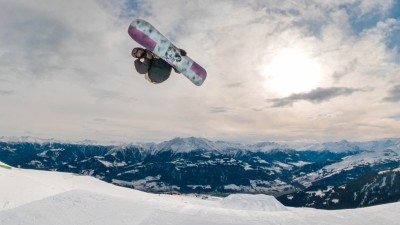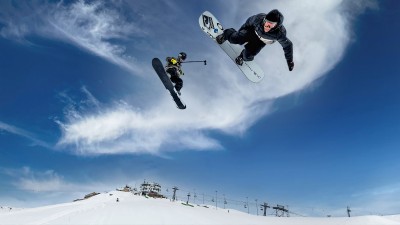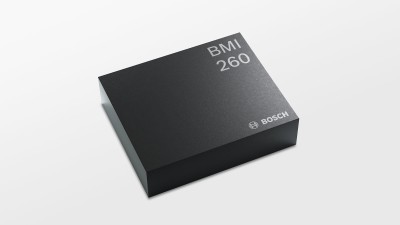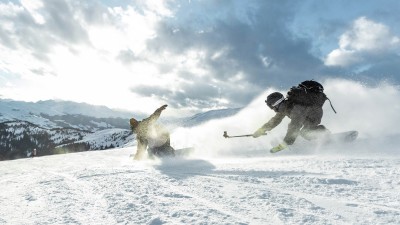OIS + IMU = OMG! How optical image stabilization ensures stable images on unstable slopes
People´s stories

For the 24-year-old athlete Yanneck Konda, the moment his board leaves the ground and he starts to fly means everything. He and his friend shoot films together about their breathtaking jumps in spectacular locations in the mountains. The BMI260 MEMS sensor from Bosch Sensortec makes it possible for the action camera videos to both be high resolution and have a razor-sharp picture. This microelectromechanical system enables the action camera to detect the direction of movement and adjust the image accordingly.
Lots of action and sharp images
Yanneck Konda’s fulfillment in life comes from having a snowboard strapped to his feet. “I want to artistically express both this feeling and my riding style,” he says. That’s why he and three friends started the sports film crew “Young and Savage.” Movements are a huge challenge for cameras – especially when it comes to winter sports. The unevenness of the slopes makes the image wobble, and the high speed and constantly changing distance to other riders make it difficult to focus. The success of the camcorder in the mid-1990s gave rise to a lively scene of amateur filmmakers who filmed themselves on the slopes. In order to capture a trick without any wobble back then, the video camera had to be fixed in place at a distance and panned. These days, two snowboarders ride right next to each other while one of them films with an action camera. The cameraman can even follow along over jumps and when the rider catches big air. The fact that the footage nevertheless stays sharp and perfectly steady is made possible by using the BMI260 inertial measurement unit from Bosch as an “image stabilization sensor.”


Snowboarding is action, concentration, and adrenaline. Filming that only works with perfect image stabilization.
MEMS sensor BMI260
The high-performance sensors in the BMI260 family are characterized by a large number of features. The basic BMI260 version combines a high-performance acceleration sensor with vehicle-approved rotation rate sensor technology. A high degree of durability against shifts in temperature and PCB stress guarantee that the movements to be measured are detected with extreme precision. The BMI263 version meets the MIPI I3CSM standard. Each module has a primary and secondary interface. Both of them can be configured for I²C or SPI independently of each other and thereby enable dual SPI configuration and the connection of camera modules or an additional sensor, such as a magnetic sensor. The IMUs offer a high-precision step counter function, movement detection, and precise data to support indoor SLAM applications (Simultaneous Localization and Mapping).

Tiny sensor with massive accuracy

It’s not for nothing that Yanneck Konda’s crew call themselves “Young and Savage”: adventure is the lifeblood of their films. “We have to dedicate one hundred percent of our concentration to riding and our safety when we film. We owe the fact that we can still film to the image stabilization technology in action cameras,” says Yanneck. If a camera is moved during exposure, blurring occurs. The BMI260, which measures just 2.5 x 3.0 x 0.8 mm³, detects the direction of movement. It contains a self-calibrating gyroscope and a high-performance acceleration sensor. It delivers the data for optical image stabilization (OIS) with extremely low latency, minimal group delays of at most 700 µs and high-precision time stamps that have an accuracy of less than 40 µs. In addition to that, it can also be used for electronic image stabilization (EIS).
6,400 times per second,
the MEMS inertial sensors from Bosch Sensortec measure the camera’s movements.
The MEMS inertial sensors from Bosch Sensortec measure the camera’s movements 6,400 times per second. On top of that, smart power management enables the IMU to run on an exceptionally low amount of power, thereby saving the action camera’s battery. At its highest output data rate (ODR) of up to 6.4 kHz, the total power consumption of the acceleration sensor and gyroscope is around 700 µA – even under extreme conditions. The BMI260 works reliably in temperatures ranging from -40°C to 85°C. For Yanneck, this is a decisive factor: “We expose the cameras to extremely low temperatures on the mountain, which affects battery life. So you notice really quickly which cameras run out of steam after a run.”
Close to the feeling and the action
Spectacular images on the slopes are the result of daring maneuvers known as follow shots. When reaching high speeds on the trails, every bit of concentration has to be on riding. “Young and Savage” relies on the BMI260 from Bosch to get sharp images.


Yanneck relies on modern techniques for the “Young and Savage” crew’s films. “Snowboarding is action, concentration, and adrenaline. Filming that only works with perfect image stabilization,” he says. Only the MEMS inertial sensors from Bosch enable the 24-year-old to express his passion as an athlete and video artist the way he wants – in incredible images.
The BMI260 MEMS sensor from Bosch Sensortec, which is built into the action cameras, delivers the data for optical image stabilization (OIS) and makes it possible to get sharp footage even under extreme conditions. A positive side effect for professional applications is that the time-consuming process of post-editing wobbly footage is no longer necessary.